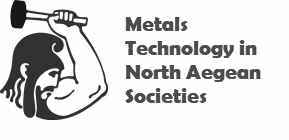Metallurgy at Pistyros : some first results
- Nerantzis Nerantzis

- May 14, 2020
- 3 min read
The ongoing systematic excavation of Pistyros was initiated in 2014 under the direction of Stratis Papadopoulos (Ephorate of Antiquities of Kavala) and up to the last summer season (2019) it has yielded large volumes of metallurgical slag representing direct proof for large scale metallurgical practices carried out in an urban context. Based on the finds so far it could be suggested that the settlement was established in the second half of the 7th century BC and was abandoned sometime during the 1st century BC. It is important to note that this fortified settlement lies within short distance to the mining zone towards the northeast. Not far from the site, about 2.5 km NE, near the modern villages of Perni and Petropigi, there are mining galleries dated tentatively to the Classical/Hellenistic period based on their square profiles (Fig 1).

Fig 1. Ancient mine entrance at Perni, Lekani mountain range (Photo: S. Nodin).
Pistyros is a unique case of an emporion, where a third of a ton of slag has been recovered during the course of excavation (Fig. 2). Importantly, the majority of the slag bears compositional similarities (based on pXRF analysis), with small numbers of slag collected from near the mines of Perni and Petropigi. By focusing on an area bounded by the three sites (Perni-Petropigi-Pistyros) and no larger than two square km, we ask the following questions: what metal(s)/type of extractive metallurgy were the inhabitants of Pistyros after? Precious (Ag and /or Au) metals or simply non-ferrous? How does Pistyros/Petropigi/Perni slag compare with contemporary silver extraction slag from Thasos based on the work of previous investigators? This is a long-term project aiming to unravel the similarities/differences between Thasian and Thracian precious metals extractive practices (7th c BC-Roman), which appear now rather blurred. Our work seeks to understand the metallurgy underpinning the minting of silver coinage in a region known for its large denominations (stater size) minted by both Greeks and Thracians.

Fig. 2 Pistyros: excavation in progress, summer season 2019 (Photo: S. Nodin).
The macroscopic study revealed that the residues consist of slag (96%), speiss (2%) and litharge (2%), suggesting primary (smelting) and secondary (melting) activity were taking place on site.
The first stage of our analytical methodology has started with non-invasive x-ray fluorescence spectroscopy with a portable device that was carried out in June 2019. Over one hundred measurements were taken and the results suggest that the waste comprises of three main groups principally identified on the presence or lack of silver contents. Morphologically they can be separated into the following a) ordinary silica-rich smelting slag (silver deficient), b) speiss (silver-rich), c) litharge (also silver-rich). Principal components analysis was performed on the data in order to check the distribution of certain elements within and among the three groups (Fig. 3). Therefore litharge (red) and speiss (green) samples form two rather distinct groups while slags display a more random distribution which is due to higher inhomogeneity in their chemical composition. Key elements driving the separation between groups are Sn and Ag (PC1) as well as As and Fe (PC2).

Fig. 3 PCA distribution of samples forming three distinct groups: litharge (red), speiss (green), slags (purple).
The coexistence of speiss and litharge previously thought to be associated with two different types of metallurgy (Ottoman and ancient) corroborates previously proposed models (Photos et al. 1989) of three liquid layers forming within the same furnace: a) slag floating on top, b) speiss separating in the middle and c) a layer rich in Pb/Ag collected at the bottom. The next stage would have been that of cupellation for the separation of lead from silver during which platy litharge was formed, characteristic examples of which were found during excavation. By delving into the Pistyros metallurgical waste, we seek to resolve issues pertaining to the complex, and still little understood, relationship between the indigenous Thracian miners and the Thasian colonists encouraging metals extraction for supplying their market based economy.
Reference
Photos E., Ch. Koukouli-Chrysanthaki, R.F. Tylecote, and G. Gialoglou. 1989. Precious Metals Extraction in Palaia Kavala, NE Greece, An Archaeometallurgical Attempt to Locate Skapte Hyle. International Old World Archaeometallurgy Conference, Der Anschnitt. Heidelberg: Max Plank Institut fur Kern Physik, 179-190.





Comments